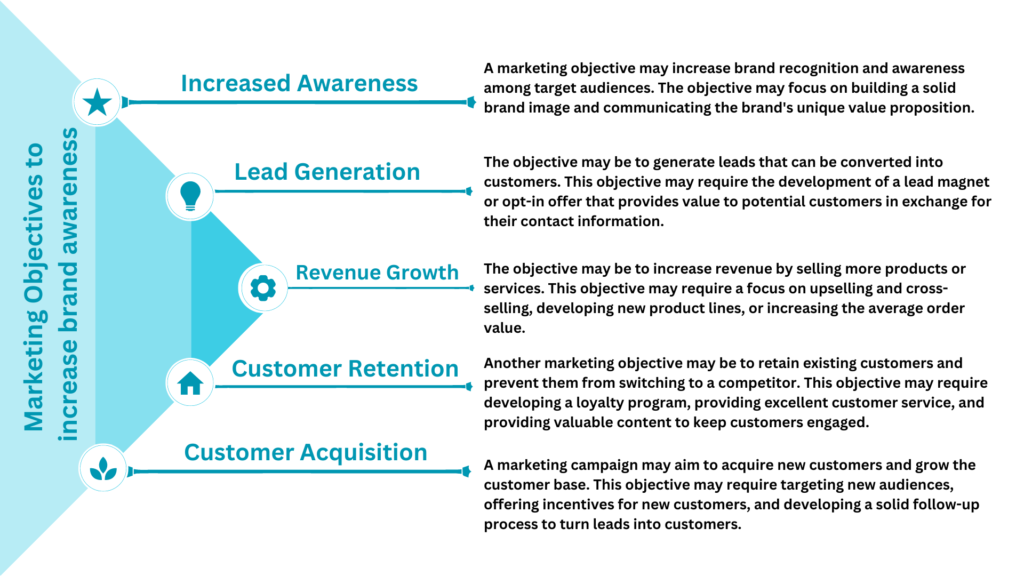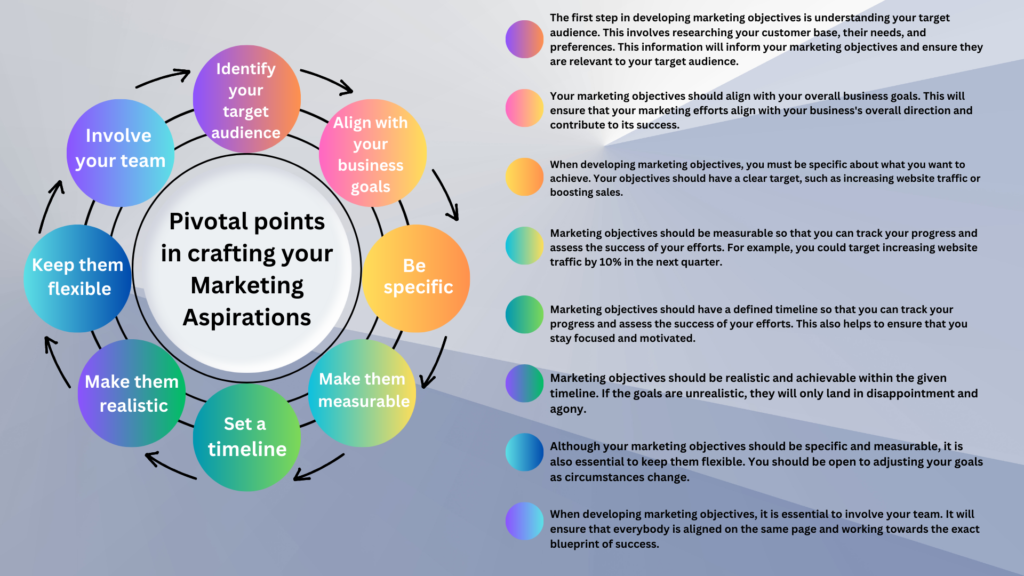
Wondering why marketing objectives are essential & how they help you in achieving your overall goals? We have enlisted all your doubts & queries in this blog for you. After reading through, hope you & your business are on a clearer path.
To begin with, marketing objectives can be best described as the goals you want to achieve through your marketing campaigns. In other words, these objectives are why you put the time, effort and resources into promoting your product or service.
The essence of defining clear marketing goals and targets but exactly why are they important? They let you know when you are successful. MO provide a roadmap for your marketing efforts so that you can stay focused and on track. Furthermore, they also help you measure the success of your campaigns and make necessary adjustments to reach your goals more effectively.
Marketing Objectives for a new product
Marketing objectives and KPIs (Key Performance Indicators) are essential components of a marketing plan. The objectives define what a marketing campaign aims to achieve, while the KPIs provide measurable metrics to track progress and evaluate the marketing campaign’s success. So, whether you’re a start-up founder trying to attain more customers or a marketing manager, it’s essential to define your MO. By doing so, you’ll be able to create targeted campaigns that drive results and help your business reach new heights.
Desired results of marketing initiatives – to increase brand awareness
Examples of marketing objectives include increasing brand awareness, generating leads, building customer loyalty, and driving sales.

Marketing Objectives: Embracing the Evolving Landscape
They have undergone a significant transformation in recent years, with digital technology and new customer preferences playing a significant role. In this fast-paced digital world, businesses must adopt new marketing strategies to keep up with the latest trends and remain competitive.
Personalization
One of the most popular marketing objectives today is personalization. Customers want a tailored experience, and businesses that can deliver this are more likely to win their loyalty. Companies use data analysis and AI technologies to personalize marketing efforts to understand their customers’ specific needs and preferences.
Video Marketing
Another trend that is taking the marketing world by storm is video marketing. A video is a powerful tool businesses can use to engage with their customers and create a deeper connection. Videos can showcase products and services, promote brand values, and even create a human connection with customers.
Social Media
Social media is another crucial aspect of marketing today. Platforms like Facebook, Instagram, and Twitter provide businesses with a direct line to their customers and allow them to interact with them in real-time. Companies use social media to create brand awareness, drive sales, and offer customer support.
Mobile Technology
Finally, the rise of mobile technology has changed how businesses approach marketing objectives. As the use of mobile devices for shopping and other activities becomes increasingly prevalent, businesses must tailor their marketing efforts to reach this growing audience through mobile optimization effectively. This includes using mobile-friendly website designs, creating mobile apps, and using mobile advertising.
Today they are about creating personalized, engaging experiences that connect with customers on a deeper level. As the tech arena continually evolves, so is the marketing landscape, and businesses that keep up with the latest trends will reap the rewards.
Pivotal points in crafting your Marketing Aspirations
As a marketer, determining objectives is one of the most crucial aspects of your job. It is the foundation upon which all your marketing strategies and tactics are built. Without clear, specific, and measurable marketing objectives, your marketing efforts will likely flop, wasting resources and time. So let us discuss the top considerations in determining marketing objectives.

So let us discuss the top considerations in determining marketing objectives.
- Identify your target audience: This involves researching your customer base, their needs, and preferences. This information will inform and ensure they are relevant to your target audience.
- Align with your business goals: Your objectives should align with your overaIdentify your target audience: The first step in developing marketing objectives ll business goals. This will ensure that your marketing efforts align with your business’s overall direction and contribute to its success.
- Be specific: When developing objectives, you must be specific about what you want to achieve. Your objectives should have a clear target, such as increasing website traffic or boosting sales.
- Make them measurable: Marketing objectives should be measurable so that you can track your progress and assess the success of your efforts. For example, you could target increasing website traffic by 10% in the next quarter.
- Set a timeline: Marketing objectives should have a defined timeline so that you can track your progress and assess the success of your efforts. This also helps to ensure that you stay focused and motivated.
- Make them realistic: Marketing objectives should be realistic and achievable within the given timeline. If the goals are unrealistic, they will only land in disappointment and agony.
- Keep them flexible: Although your marketing objectives should be specific and measurable, it is also essential to keep them flexible. You should be open to adjusting your goals as circumstances change.
- Involve your team: When developing marketing objectives, it is essential to involve your team. It will ensure that everybody is aligned on the same page and working towards the exact blueprint of success.
Why is Marketing with Objectives Important?
Developing requires staying up-to-date with trends and continuously adapting to meet the evolving needs of customers and the marketplace. Moreover, defining your marketing strategy and ensuring that your efforts align with your overall business goals is essential. By following these steps, you can develop marketing objectives that are specific, measurable, and achievable and that help drive your business forward. Remember to keep your objectives flexible and involve your team to ensure success.
FAQs
- What are the different examples of short and long marketing objectives?
These are some of the popular examples of long and short-marketing objectives.
Short – reduced priced promotions, group offers, pay-per-click advertising, trade shows.
Long – Working on Search engine optimization, Public relations, publishing and promoting content, and social media.
- What is the impact of Marketing without strategy?
Without a clear marketing strategy, a business plan can fail abruptly. Where the sales pipeline is unable to grow, and the competitors can easily outperform you.
- What are the marketing objectives for nonprofit organizations?
These are the top marketing objectives for a nonprofit organization
- Acquire new members or donors.
- Deepen community engagement.
- Raise awareness of a worthwhile mission.
- Become a thought leader and go-to resource on an issue.
- Increase your volunteer network.
Too much information? You can browse through the rest of our website and have some fun! Ye Bhi Theek Hai.









